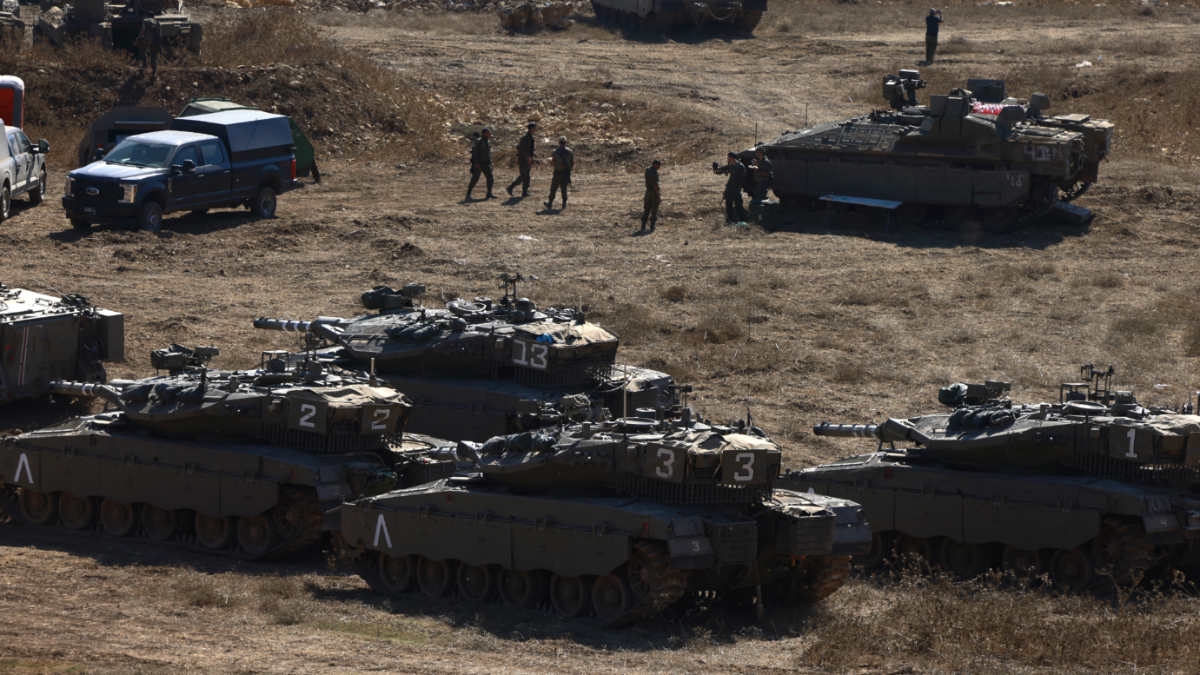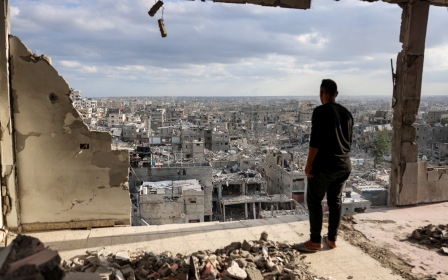US annual military aid to Israel quadrupled since 7 October attacks

The US has spent at least $22bn dollars on military aid to Israel and the management of spillover conflicts spawned by its war on Gaza over the past year, according to a new report examining US military spending.
The US has provided Israel with $17.9bn in military aid alone since the 7 October Hamas-led attacks on southern Israel, the highest amount of military aid in the two countries' histories, adjusted for inflation.
The Biden administration pledged to support Israel unconditionally following the October 2023 attacks and has ensured a steady supply of arms despite opposition from some US officials, lawmakers and many human rights groups concerned about the devastating impact Israel's offensive has had on civilians in Gaza, and now the West Bank and Lebanon.
The figure surpasses US military aid to its ally during the 1973 Arab-Israeli war and after the signing of a historic peace treaty between Egypt and Israel.
For comparison, the dollar figure is also roughly quadruple the amount Israel received in the 1980s during its war with the Palestinian Liberation Organisation in Lebanon, its 15-year occupation of Lebanon, and its 2006 war with Hezbollah.
New MEE newsletter: Jerusalem Dispatch
Sign up to get the latest insights and analysis on Israel-Palestine, alongside Turkey Unpacked and other MEE newsletters
The US has provided $6.8bn in foreign military finance (FMF), or aid, to Israel from 7 October 2023 to September 2024, according to the report published by Brown University’s Watson Institute for International and Public Affairs.
In addition, the US has provided $4.5bn in missile defence supplies and spent $1bn bolstering Israel’s artillery production. Israel has utilised munitions at a rapid pace, striking Gaza and Lebanon. Last week, it also activated its ballistic missile defence, the Arrow System, to shoot down roughly 180 missiles fired by Iran.
The US also dipped into its own stockpile of military supplies to provide Israel with $4.4bn worth of additional weapons.
In April, Biden signed into law a bill providing Israel with $1.2 billion to develop a laser missile defence system designed to augment its current three-tiered defence system, including the Iron Dome, David’s Sling and Arrow System.
Defending against Houthi attacks costs US billions
The US has also spent an additional $4.86bn funding military operations that the authors note started after Israel’s war on Gaza began. In 2024, Congress approved an additional $2.4bn for the US military to respond to attacks.
In October 2023, a collection of militias backed by Iran, known as the "axis of resistance", began attacking Israel, but also US and western assets in the region. The groups said their attacks were in solidarity with besieged Palestinians in Gaza.
From Lebanon, Hezbollah attacked Israel starting on 8 October 2023. Meanwhile, Shia militias in Iraq launched attacks on US bases and the Houthis in Yemen started targeting commercial shipping and US military vessels.
The authors of the report argue the US has already spent the $2.4bn appropriated by Congress and has had to tap additional funds to support the rotating deployment of as many as two aircraft carriers.
“The fully loaded cost per day of operating a carrier strike group has been estimated at $8.7 million (in inflation-adjusted dollars), which is equal to $2.7 billion per year,” the authors note.
“Given all these factors, it is reasonable to estimate that the US is on pace to spend at least double the $2.4 billion already appropriated for regional defense”.
The Houthis have fought a yearslong war with Saudi Arabia, though there is a truce currently, using cheap missiles and drones that the kingdom had to shoot down with expensive interceptors. The US faces the same problem patrolling the Red Sea.
According to the Pentagon, during the nine months the USS Eisenhower carrier strike group spent patrolling the region, it fired 135 Tomahawk land attack missiles and 155 standard missiles at Houthi targets, which equates to roughly $800m dollars.
“At this rate, it is likely that the Pentagon will need at least another $1.5-$2 billion in emergency funding over the next few months,” the authors wrote.
Israel secures $20bn in future military aid
Even before its war on Gaza, Israel was the largest recipient of US military aid, receiving about $3.8bn annually. Most of that aid came from FMF. The $17.9bn cited by Brown takes into account the old allotment.
The Brown University tally underscores how US taxpayer dollars going to Israel’s security have surged in the past year. But the authors cautioned it is likely an underestimate.
As the US’s closest Middle East ally, Israel is looped into America’s defence industry and regularly receives military supplies from old orders. The Biden administration has also made at least 100 arms deals to Israel since October 2023 that fall below the value that requires congressional notification.
“The figure of $17.9bn in US security assistance to Israel from October 2023 to September 2024 is a fraction of the full value of US support for this war, which will only be determined over time," the authors of the report said.
Israel and the US have also sealed new military aid deals during the last year. In August, the Biden administration announced $20.3bn in new FMF agreements with Israel, some of which, like new F-15 warplane deliveries, will take several years to complete.
The US maintains security ties with its partners across the Middle East, but Israel has several advantages.
Unlike Egypt, the second-largest recipient of FMF, Israel is able to finance its military purchases before its aid is approved by Congress, in a process known as “cash flow” financing. This form of credit allows Israel to receive big-ticket military items, like warplanes, and defer payment into the future.
The US also engages with Israel on high-tech military sales to other partners to ensure that Israel maintains a “qualitative military edge” over its neighbours. For example, as part of the UAE’s decision to normalise relations with Israel, the government said it would not oppose the sale of F-35 fighter jets to the UAE. That deal fell through over US concerns about Emirati-Chinese defence ties.
Middle East Eye delivers independent and unrivalled coverage and analysis of the Middle East, North Africa and beyond. To learn more about republishing this content and the associated fees, please fill out this form. More about MEE can be found here.






